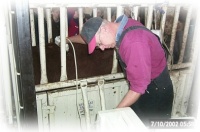| | Why measure feed efficiency
The cost of feed is second only to fixed costs in importance to the profitability of commercial beef operations and 70-75% of the total dietary energy cost in beef production is used for maintenance, including maintenance of the dam. In addition, a 5% improvement in feed efficiency could have an economic impact four times greater than a 5% improvement in average daily gain.
Defining net feed efficiency
Net feed efficiency or net feed intake (NFI) is defined as the difference between an animal's actual feed intake and its expected feed requirements for maintenance and growth. Thus, it is the variation in feed intake that remains after the requirements for maintenance and growth have been removed. Like a golf score, a lower value is better and indicates an efficient animal.
Considerable variation exists between individual animals within breeds or genetic strains in NFI. This infers that substantial progress can be made in NFI or feed efficiency since the heritability of the trait is approximately 40%.

The trial
The main purpose of this three-year trial was to showcase the net feed efficiency technology to Alberta's beef industry and to identify feed efficient breeding bulls. Ultimately we hoped to improve the efficiency of the cowherd and feeder cattle in order to reduce unit costs of production.
 The trial took place at the newly renovated cattle facilities at the Beef Centre at Olds College. The trial began on October 7, 2002 with approximately 80 bull calves, averaging 7 to 8 months of age. The bulls were subjected to a 140-day trial for net feed intake. The genetic make-up of the group was 16 bull calves from each of five major seed-stock breeds in Alberta. These breeds were contacted to ensure we had enough bulls on test. Each group of 16 consisted of four half-sib groups of four bull calves (4 sons of the same sire/half-sib group). These bulls were placed into two pens, with the British bulls on one side and the Continental bulls on the other side. Each pen was fitted with a GrowSafe System (GrowSafe Systems Ltd., Airdrie, Alberta) for automatically monitoring individual animal feed intake. The trial took place at the newly renovated cattle facilities at the Beef Centre at Olds College. The trial began on October 7, 2002 with approximately 80 bull calves, averaging 7 to 8 months of age. The bulls were subjected to a 140-day trial for net feed intake. The genetic make-up of the group was 16 bull calves from each of five major seed-stock breeds in Alberta. These breeds were contacted to ensure we had enough bulls on test. Each group of 16 consisted of four half-sib groups of four bull calves (4 sons of the same sire/half-sib group). These bulls were placed into two pens, with the British bulls on one side and the Continental bulls on the other side. Each pen was fitted with a GrowSafe System (GrowSafe Systems Ltd., Airdrie, Alberta) for automatically monitoring individual animal feed intake.
The trial started with a 28-day adjustment period, followed by a 112 day test period. Each animal was weighed every 14 days and measured for hip height, body condition score, back-fat thickness, rib-eye area, and marbling score using real-time ultrasound every 28 days. The adjustment and test period diets were similar to those used in standard bull test stations. Historical data from the seed-stock associations was collected on the bull calves, their siblings and their sire and dam. This information included calving, pre-weaning, and post-weaning data from siblings, and weight and body condition score at weaning.
Breeders received monthly reports on the trial including feed intake, growth rate, and ultrasound data (back-fat, rib-eye area and marbling score) via web site, e-mail, fax or mail. Genetic merit values (EPDs and genetic markers) were generated for net feed intake to aid in future selection programs for net feed efficiency.
A more complete report on the Commercialization of Net Feed Efficiency as presented by John A. Basarab, Mick A. Price and Erasmus K. Okine may be viewed in pdf format. Western_Nut_Conf_2002_NetFeedEfficiency.pdf (290 kb).
For more information call:
Patrick Ramsey, Beef Specialist - New Technologies, Alberta Agriculture Food & Rural Development, High River, 403-652-8303.
Neil French, Instructor - Agriculture Production, Ag. Production, Business and Animal Science, Olds College, Olds, 403-556-4722 |
|